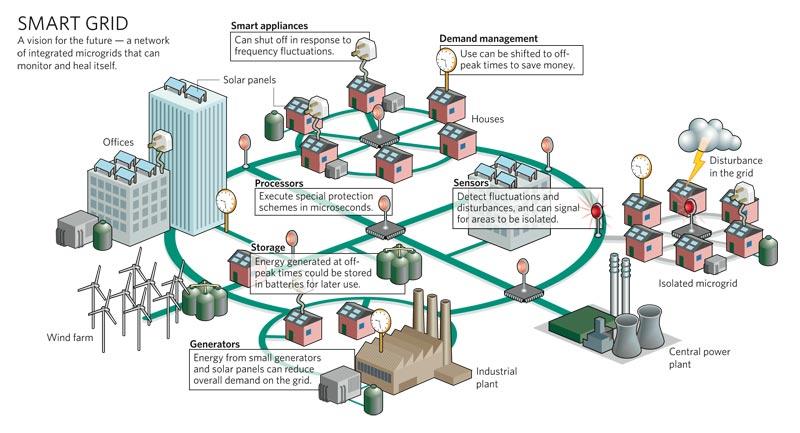
Exemplary model of the future Smart Grid – Automation in Electricity
The “smart grid” is a rapidly growing set of technologies, processes, devices and applications that affect and enhance the traditional electric grid.
These advances are partially driven by exponentially growing demands worldwide for energy as expressed in a commonly repeated statistic that “global electricity demand is expected to increase 75% by 2030.”
What’s happening with the smart grid also reflects developments made in communications, from Internet to cellular to wireless, as well as higher expectations from consumers regarding energy availability, rising energy costs and access to their energy information.
A smarter grid will also help integrate renewable energy including wind and solar into the energy mix.
Defining the Smart Grid
To understand the smart grid, you first need to get familiar with the 125-year-old electric grid. Most people don’t think about where the electricity they’re using comes from or how it gets to their homes and offices.
The electric grid consists of several main touchpoints in an overall system that gets electricity from creation to the end user:
The main touchpoints for electricity include:
- Generation — the creation of electrons that make up electricity.
- Transmission — moving high-voltage power from generators at power plants through transmission lines, reducing it down to 12,000 volts.
- Distribution — where transformers convert power to the 110 volts running in residentials
- Retail — the metering, monitoring, and measuring of power usage that results in a bill to the consumer from a utility company.
- Customer/Consumption — the end user experience with the power.

Diagram of how a conventional grid looks like
Smart grid technologies and innovations occur at — and can affect — any and all steps of the electricity ecosystem. Some are more focused on the utility side while others address the customer.
Smart Grid Developments
In the “old days” up until the last 10 to 15 years, utility workers — meter readers — were deployed into neighborhoods to read and write down data retrieved from energy meters in people’s back yards.
The first major change to this process came in the form of Automatic Meter Reading (AMR), through which meters communicate via a one-way signal to a truck that is driven through neighborhoods to collect data.
With advancement in technology, there’s the Advanced Metering Infrastructure (AMI) going beyond just reading meters and sending data to utilities — it also sends information back to the home and to the consumer.

With AMI, information can be transmitted to individual homeowners as well as utility offices for record purposes.
Smart meters aren’t effective without some kind of communications method to transmit data such as cellular, Wi-Fi or other wireless protocols.
Unlike cellular systems such as GSM and GDMA, Phoenix Contact’s wireless system isn’t optimized for tens of users but instead for tens of thousands of “users” that are in actuality devices, such as meters and sensors.
Our system is designed for extremely long-range and broad coverage so utility companies can deploy these communication networks more cheaply and reach more devices more effectively.
Other interesting developments in the Smart Grid would be the availability of web portals and dashboards that present aggregated power usage data in ways that are understood even by laypersons.
Such software and services, connecting to the Internet display real-time data about the power consumption via a short-range wireless system.
Information like these was never thought of before and it can assist in regulating power consumption in homes or in industrial plants, saving tons from electricity wastage.
Eventually, with systems like this along with “time-of-day pricing,” you will know exactly how much money you’re spending down to the minute, and you’ll be able to modify your behavior to use your appliances at different times.
Or better yet, you’ll benefit from an automated system that regulates usage for you based on your usage habits and peak usage times to run certain appliances at “cheaper” times of the day.
Global Smart Grid Adoption is Going Strong
Smart grid adoption is happening across the globe. Examples are:
- Toronto, Ontario, Canada— Ontario was the first province in Canada to introduce what is referred to as “time-of-use pricing.” The system is said to have 100% smart meter deployment.
- Texas, U.S.— The electricity market in the state of Texas has been deregulated, and the state has close to a 100% saturation of smart meters along with an automated system to give customers their energy usage data through smart grid technology and web portals.
- Scandinavia— At 100% penetration, citizens of Sweden and Finland are seeing the benefits of the smart grid, including in-home smart technologies.
While the United States may be spending the most money on smart grid tech innovation and deployment, other countries making significant headway with implementation include Australia, New Zealand and parts of Europe, including Germany, Spain, the United Kingdom and France.
In Asia, while Japan and South Korea are already heavily invested in the smart grid, China is poised to become a major investor. Asia and Latin America are seen as emerging smart grid markets as they roll out smart meter programs in India and Brazil.

Electric cables in Japan
In future, for Smart Grid technology to further grow exponentially, the following implementations need to be considered:
- Data connection between demand (when you turn a light on) and generation (energy being created in a power plant). If you can get more granular data about usage, you can better forecast energy needs and usage, which then can be applied to create more efficient energy generation.
- Electricity storage. When there’s low energy demand, excess energy should be able to be stored and then accessed or discharged during peak usage periods. For an example of storage on a small scale, consider an electric vehicle — when turned off and plugged in, it’s storing energy to be used during the day when the car is running.
- Automated energy efficiency for consumers. Businesses do not usually have the time or inclination to proactively make their offices, factories and other environments more energy-efficient. In order to reduce energy usage and shift grid load, we need more services that automatically make smarter energy choices.
- The private market needs to step up to the plate. Instead of relying on government-sponsored programs, the private sector needs to develop products and/or services that can be easily packaged and delivered to consumers. For example, a telecom company could add an energy efficiency program to its offerings, adding a commercial layer to the smart grid so it becomes more accessible to consumers.
Regardless of where the innovations are coming from, smart grid infrastructure serves utilities and consumers by leveraging information technology to bring advanced communications to a previously “dumb” network.
By putting a greater emphasis on information retrieval, aggregation, reporting and analysis, the potential to save on energy and modify energy consumption behavior can benefit everyone.
Feel free to contact us at marketing@phoenixcontact.com.sg to find out more!












